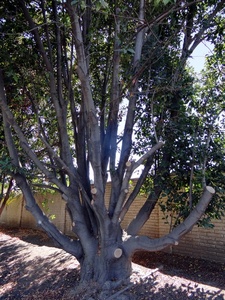Bay Laurel Trees are trees in the laurel family, which also includes Avocado trees. They are fairly primitive forms of flowering plants, related to magnolia trees and pipevines. They are not at all closely related to Cherry Laurel trees, which get the "Laurel" part of their name from a visual resemblance of their leaves to the leaves of bay laurel trees.
Laurel Drive in eastern Woodland is probably named for bay laurel trees. Camphor Drive in eastern Woodland is probably named for the Camphor Laurel.
There are nearly 3,000 species in the laurel family, but only three are likely to be seen growing in or near Woodland. One is native to Woodland, and two others are sometimes planted by the city of Woodland—and the leaves of one of these are commonly sold in grocery stores.
Native to Woodland
California Bay Laurel (Umbellularia californica) is an evergreen tree native to the southwestern half of Woodland, as well as from Woodland south to Davis, and also in the Yolo County foothills, including the Capay Hills. California Bay Laurel trees can take on a wide variety of sizes and shapes to suit their environmental conditions, growing up to 100 feet tall or remaining as small shrubs; most often, they grow about 20 to 40 feet tall. They prefer full sun to partial shade and are equally likely to grow in wetlands or uplands. The flesh of their fruits can be eaten when ripe, or dried and then eaten. The hard inner seed of each fruit, similar to an avocado pit, is called a "bay nut" and can be roasted to achieve a flavor resembling roasted coffee beans or dark chocolate. It can then be eaten whole or ground into powder and used as flavoring for food or beverages. California Bay Laurel leaves contain a toxic compound not present in European bay leaves, so eating the leaves or using them in cooking is not recommended. California Bay Laurel has "perfect" flowers (containing both male and female parts in the same flower). They are ranked 6 out of 10 on the Ogren Plant Allergy Scale, indicating a moderate tendency to cause hay fever. There are California Bay Laurel trees planted in City Park and John Ferns Park. Two were planted in John Ferns Park in 1979 when the nature area there was first installed, and both of those are still alive to this day. Additionally, California Bay Laurels are planted as street trees on 3rd Street, Beamer Street, Cross Street, and Dog Gone Alley.
Non-Native
Camphor Laurel (Camphora officinarum) is an evergreen tree from Asia. It usually grows about 70 to 100 feet tall. It is a main source of camphor and smells like camphor. It prefers full sun. Its has "perfect" flowers (containing both male and female parts in the same flower). Camphor Laurel is ranked 8 out of 10 on the Ogren Plant Allergy Scale, indicating that it tends to cause fairly severe hay fever. It is planted in William Crawford, Sr., Park. It is also planted as a street tree on 1st Street, 2nd Street, 3rd Street, 5th Street, Clover Street, Cross Street, Elm Street, North Street, and Pendegast Street.
 European Bay Laurel (Laurus nobilis) on West Kentucky Avenue. Photo by queerbychoice.European Bay Laurel (Laurus nobilis) is an evergreen tree from the Mediterranean region and the source of the bay leaves commonly used in cooking. There are European Bay Laurel trees planted in Beamer Park, John Ferns Park, Wayne Cline Park, and Woodside Park. They are also planted as street trees on 1st Street, Bartlett Avenue, East Gibson Road, Elm Street, Grand Avenue, and Oak Avenue. European Bay Laurel trees usually grow about 20 to 60 feet tall but can be kept pruned as small shrubs or used for topiary. These trees are either male or female, so they do not produce seedlings unless there are both male and female trees in the area. Only the male trees produce pollen, but the male trees are ranked 9 out of 10 on the Ogren Plant Allergy Scale, indicating that they tend to cause severe hay fever. They bloom from about February through April, so if you suffer from hay fever during those months, European Bay Laurel trees could be the culprits.
European Bay Laurel (Laurus nobilis) on West Kentucky Avenue. Photo by queerbychoice.European Bay Laurel (Laurus nobilis) is an evergreen tree from the Mediterranean region and the source of the bay leaves commonly used in cooking. There are European Bay Laurel trees planted in Beamer Park, John Ferns Park, Wayne Cline Park, and Woodside Park. They are also planted as street trees on 1st Street, Bartlett Avenue, East Gibson Road, Elm Street, Grand Avenue, and Oak Avenue. European Bay Laurel trees usually grow about 20 to 60 feet tall but can be kept pruned as small shrubs or used for topiary. These trees are either male or female, so they do not produce seedlings unless there are both male and female trees in the area. Only the male trees produce pollen, but the male trees are ranked 9 out of 10 on the Ogren Plant Allergy Scale, indicating that they tend to cause severe hay fever. They bloom from about February through April, so if you suffer from hay fever during those months, European Bay Laurel trees could be the culprits.
Links
CalScape: Umbellularia californica
Wikipedia: Umbellularia californica


